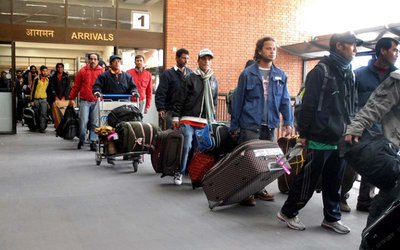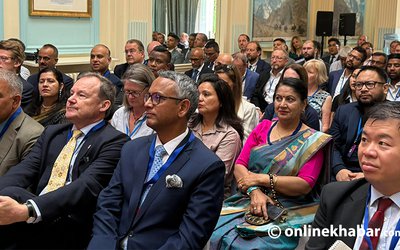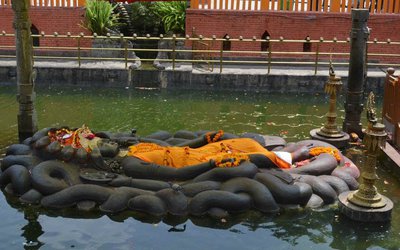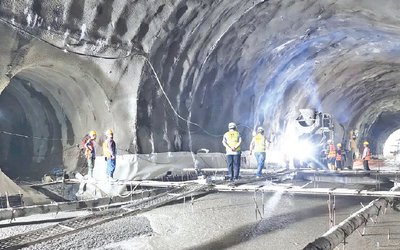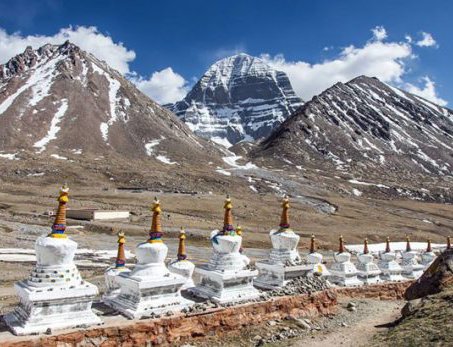
Our long-cherished dream of embarking on a pilgrimage to the sacred Mount Kailash and bathing in the holy Mansarovar Lake had remained just a desire for a while. We faced difficulties in organizing such a journey due to the absence of like-minded individuals to accompany us. However, approximately three months ago, our friend, retired army colonel Ashok Kumar Thapa, extended an invitation. He had successfully formed a small group for a pilgrimage to Mansarovar Lake and Mount Kailash. This tour also included a two-day sightseeing excursion in Lhasa and its surrounding areas, and Colonel Thapa had meticulously chosen an experienced and reputable travel agency, Yolo Hike, to manage our journey. Given our longstanding aspiration for such a pilgrimage, we couldn't pass up this opportunity.
On August 27, 2023, our group, consisting of about 20 people, embarked on a 12-day journey that would lead us to Mansarovar, Kailash, and eventually Lhasa on our return. The group comprised both old and new friends, people we had known for quite some time. Our tour was impeccably organized by Yolo Hike, an experienced travel and tour company that had been arranging such trips to Tibet in collaboration with local tour companies for a considerable period. Our first night of the journey was spent comfortably in a hotel at Syabrubesi, located along the Pasang Lhamu Highway, roughly 17 kilometers from Timure at Rasuwagadhi, the border crossing point between Tibet and Nepal. The accommodation was delightful. However, the bus ride between Rasuwagadhi and Betrawati River, the border dividing Nuwakot and Rasuwa districts, was less pleasant due to the deplorable road conditions.
The following morning, on August 28, we proceeded to Timure, where we faced about four hours of waiting at the Nepal and Chinese Immigration Offices. This was primarily due to the large number of Nepali nationals traveling to Mansarovar and Kailash. The scene on the Nepali side of the border was chaotic and disorganized, with limited space at the immigration office and a lack of assistance for travelers awaiting exit clearance. It was disheartening to see that not much improvement had occurred since my previous visit to the Timure Immigration Office a few years back. In stark contrast, the scene on the Chinese side was characterized by organization, discipline, and efficient management. Although the process at the Chinese Immigration and Customs Office was time-consuming, tourists displayed remarkable patience, waiting their turn to have their documents processed. Following clearance from the Chinese authorities, we proceeded towards Kyirung on a Chinese tourist bus, which offered reasonable comfort. Our journey included two security checkpoints between the border and Kyirung, underscoring the prevailing tight security situation throughout the region.
Kyirung, a small modern town situated at an altitude of 3,000 meters on the eastern bank of the Kyirong Tsangpo river, made for our next destination. It serves as a major commercial center for bilateral trade between China and Nepal. The affluence of the local population was evident, with numerous modern restaurants and shopping centers. Interestingly, we observed several Nepali entrepreneurs running restaurants and beauty parlors in the area, while Nepali laborers from bordering districts readily found employment in Kyirung. It appeared that these Nepali workers did not require formal visas to enter Tibet's neighboring regions and could easily obtain government permits to work there. Conversations with some Nepali workers revealed that a substantial number of Nepalis, particularly in the construction industry, were employed in Kyirung and nearby Tibetan towns. Kyirung's historical ties with Nepal were further exemplified by the presence of a beautiful Nepali temple, constructed by Newari craftsmen from Nepal in fulfillment of Princess Bhrikuti's wish. Princess Bhrikuti, also known as Harit Tara, was the daughter of Amshuvarma, the then LICCHAVI King of Nepal. Bhrikuti's devout Buddhism led her to bring sacred images and skilled Newari craftsmen with her as part of her dowry when she married Songtsen Gampo, the Emperor of Tibet, in the 7th century. Numerous Nepali temples were erected in Kyirung, Lhasa, and Shigatse as per Bhrikuti's wishes, fostering historical ties between China and Nepal. Emperor Songtsen Gampo's marriage to Chinese Princess Wencheng, also known as White Tara in Tibet, further solidified these bonds. Bhrikuti and Wencheng worked together to establish various temples in Tibet and China, playing a significant role in spreading Buddhism in Tibet.
In the early hours of August 29, we departed for Saga on our way to Mansarovar, located approximately 170 kilometers from Kyirung. Along the route, we passed through the original Kyirung, about 30 kilometers from the modern Kyirung. We also marveled at a picturesque waterfall, situated just 23 kilometers from Kyirung, which attracted both Tibetan and other tourists. The journey smoothly took us through various mountain passes, with Thong La, standing at 5,232 meters, being the tallest. La Lung, at about 5,220 meters, was the second highest pass we crossed. Although we briefly stopped at Thong La pass for about 20 minutes, the extreme wind made the experience quite challenging. Consequently, we hastened to reach Saga, located at an altitude of approximately 4,640 meters. Along the way, we encountered Lake Peikutso and numerous sheep grazing lands, witnessing nomadic herders tending to yaks and sheep, often guarded by trained dogs. It piqued our curiosity about whether nomads were inclined to send their children to school. According to our Tibetan tour guide, it is mandatory for all Tibetan families, including nomads, to send their children to school. Failure to do so results in punitive measures. Our journey to Saga lasted about 6 hours, where we found yet another small but prosperous town serving as a commercial hub for that part of Tibet. The presence of brand new cars, well-stocked shopping centers, and modern amenities was evident. The region's impressive road infrastructure included the development of numerous solar plants on hilltops, serving as a major source of electric power for local residents.
On the early morning of August 30, we made our way to Darchen via Paryang. Darchen, a small village town near Mansarovar Lake, serves as a crucial stopover for most pilgrims visiting Mansarovar and Mount Kailash, as the lake area lacks hotel facilities. The journey took us approximately seven hours, during which we were treated to awe-inspiring views of the sacred Mount Kailash. Our route followed the course of the Brahmaputra River, believed to originate from Mansarovar. The Brahmaputra flows from Tibet to Assam State of India, it then enters into Bangladesh where it is called Padma river, and eventually merges with the River Ganges at Ganga Sagar near Calcutta. Mansarovar Lake is also the source of other major rivers in South Asia, such as the Sutlej River and the Karnali River in western Nepal. The Karnali River originates from Rakshastal, a saltwater endorheic lake that overflows from Mansarovar.
On the morning of August 31, we finally arrived at Mansarovar Lake, where we embarked on a holy bath ritual. To maintain the purity of the sacred lake, the local government had implemented a restriction on full immersion, providing travelers with buckets of warm and cold water for bathing. Given that August 31 coincided with Janai Purnima, a significant Hindu festival, we were fortunate to receive rakshabandhan from Nepali pandits who had gathered there to perform religious ceremonies. We joined another Nepali pilgrimage group in performing puja, which included homa, the lighting of lamps, and meditation. Our experience at Mansarovar was unforgettable and spiritually enriching. Following our rituals and prayers, we explored the area, including a parikrama (circle) around Mansarovar and Rakshastal. Although we did not complete the full circuit, our journey left us with lasting memories.
Situated in the southwestern region of Tibet, Mansarovar Lake is a mere 50 kilometers from the border of Nepal's Humla district to the northwest. Nestled at an elevation of 4,590 meters above sea level, it stands as one of the highest freshwater lakes in Asia, with Tilicho Lake in Nepal being the highest at 4,919 meters. Lake Mansarovar boasts a roughly circular shape with an 88-kilometer circumference, a depth of about 90 meters, and a surface area of around 320 square kilometers. This sacred site holds immense significance in Hinduism, as ancient Hindu texts mention it as the mythical Mount Menu and Lake Manasa. These are believed to be synonymous with Mount Kailash and Mansarovar, which are equally sacred to Buddhists and Jains. Hindus hold that Lord Shiva tamed Lake Manasarovar, sending its waters to nourish the fertile valleys beneath the Himalayas.
In the early hours of September 1, we set out for the small settlement of Tarboche, also known as Darboche, which serves as the starting point for the Kailash Kora (parikrama). Located here is Yamadwar, the Gateway of the God of Death, which marks the commencement of the Kailash Parikrama. This grueling journey takes around three days on foot and is not recommended for adults or those prone to high altitude sickness. The Yama Dwar holds immense significance for Hindus, Jains, and Buddhists alike, as it serves as the base camp of Mount Kailash, revered as the heavenly abode of Lord Shiva for Hindus and the birthplace of Jainism. Indeed, for adherents of these religions, this destination embodies supreme divinity. After conducting pujas and meditating for a few hours, our tour group returned to Saga for an overnight stay.
On the morning of September 2, we departed from Saga for Shigatse, en route to Lhasa. The journey took approximately nine hours and featured numerous mountain passes exceeding 4,500 meters in altitude. The eastern part of Tibet, through which we traversed, appeared greener in comparison to the western region. Solar plants dotted the hilltops, supplying much of the local population's electricity needs for both households and industries. We also noted extensive agricultural activity, with lush farms cultivating crops, vegetables, and fruits as we approached Shigatse. Shigatse, whose name means "fertile land," is strategically located at the confluence of the Yarlong Tsangpo and Nyangchu rivers, boasting Tibet's most fertile land. Of particular note was the impressive irrigation system developed in the region, with irrigation pipes crisscrossing the landscape, bringing water from distant sources. We inquired about access to irrigation, agricultural inputs, and marketing for farmers, and our Tibetan tour guide informed us that the government had made significant investments in agricultural development in Tibet. Consequently, farmers had no trouble obtaining necessary inputs, resulting in a three- to four-fold increase in agricultural productivity compared to the 1980s or 1990s. We reached Shigatse shortly before sunset, affording us a limited opportunity to explore the city. Nonetheless, we managed to visit some places of interest and market areas during our return journey from Lhasa.
Shigatse, a modern and sprawling city with wide boulevards teeming with traffic, serves as the capital of the Tsang Province and is Tibet's second-largest prefecture-level city after Lhasa. It is home to the Tashilhunpo Monastery, historically the official seat of the Panchen Lama since the era of the Fifth Dalai Lama. Tashilhunpo Monastery holds a central place of importance in Shigatse, having been established in 1447 by the First Dalai Lama. As one traverses the city, the eye is invariably drawn to Shigatse Dzong, resembling the Potala Palace, perched high atop a hill, overlooking the city. Shigatse has a rich cultural and historical connection with Nepal, as evidenced by the Gurkha invasion of Shigatse around 1791. Although the Gurkhas were repelled by Tibetan and Chinese armies, the historical ties between Shigatse and Nepal persist to this day. In Shigatse, one can find numerous Nepali restaurants and retail shops, often run by Nepalese entrepreneurs. It is common to encounter Tibetans in Shigatse who can fluently speak Nepali. The city enjoys a strategic location, lying approximately 250 kilometers southwest of Lhasa, with Mount Everest (Chomolongma) situated about 300 kilometers from the city center. A well-constructed highway connects Shigatse with the Nepal-Tibet border, making it an indispensable part of any Tibet tour.
In the early hours of September 3, we departed for Lhasa, with two main highways leading to the city. One route, the scenic road, passes through Yamdroke Lake, Karola glaciers, and Gyantse Monastery, albeit being longer. The other route, shorter and characterized by tunnels along the fast train track, served as our return journey. While en route to Lhasa, we took the scenic route, affording us the opportunity to stop at various tourist centers and marketplaces, engaging with local residents along the way. Regardless of our location, we consistently encountered friendly and helpful individuals. We arrived in Lhasa in the late afternoon, providing us with time to explore the city, which rests on the north bank of the Lhasa River, a tributary of the Yarlung Zangbo, also known as the Brahmaputra River. In the evening, we marveled at the illuminated Potala Palace, perched atop Red Mountain at an elevation of 3,700 meters. This iconic structure once served as the winter residence of the Dalai Lama until the present Dalai Lama fled to India in the early 1950s. The palace boasts around 1,000 rooms, including the Dalai Lama's living quarters, murals, chapels, and tombs. The Red Palace, rebuilt into the thirteen-story Potala Palace by the Fifth Dalai Lama, was initially constructed by Newari craftsmen according to the wishes of Princess Bhrikuti. Her dowry also included instructions for the construction of the Tubwang and other statues in Samye, Tibet's first Buddhist Gompa. Araniko, a Nepali craftsman, was dispatched to Shangdu by Chinese/Mongolian Emperor Kublai Khan, where he constructed the White Stupa of Miaoying Temple in Beijing. This stupa, better known as the White Dagoba, took ten years to complete and still stands as one of China's oldest Buddhist stupas.
Lhasa's altitude stands at approximately 3,650 meters, and its Potala Palace was designated a UNESCO World Heritage Site in 1994. Jokhang Temple and the Norbuglinkha were subsequently added to the site in 2000 and 2001, respectively. The University of Tibet, established in 1951 and reorganized in 1985, serves as the city's primary institution of higher learning. The Potala Palace, a religious and administrative complex, stands as a testament to the enduring history of Tibet, with its construction dating back to the 7th century under King Srong Tsan Gampo. Successive Dalai Lamas contributed to its expansion and completion in the 18th century, resulting in more than 200,000 statues and 10,000 altars within the sacred complex.
The historical ties between Nepal and Tibet trace their origins to ancient times. The relationship between these two regions has endured, with the Sherpas, Gurungs, and Thakali people of Nepal sharing close linguistic, cultural, marital, and ethnic connections with the people of Tibet. This connection persisted even after China's takeover of Tibet in the early 1950s. Nepal is the sole country to maintain a consulate office in Lhasa, underscoring the longstanding economic and cultural ties between Tibet and Nepal. Until 1950, bilateral trade between Tibet and Nepal was robust, with hundreds of Nepalese traders residing in Tibet for centuries. While many of these traders returned to Nepal after Tibet's annexation by China in 1960, some families continue to operate businesses in major Tibetan cities such as Lhasa and Shigatse. During our visit to Lhasa, we had the privilege of visiting the Consulate General of Nepal and engaging in discussions. According to the Consulate General, several Nepali business entities are still active in major urban areas of Tibet, and Nepalese individuals are well-respected and treated with kindness.
On the morning of September 5, we commenced our return journey to Kathmandu, departing from Shigatse. This time, we opted for the shorter route, which closely followed the high-speed train track. We learned that the train journey from Lhasa to Shigatse takes a mere four hours, with two daily departures. Throughout our travels, we observed how China has rapidly transformed Tibet's economy and the lives of its people. We arrived in Shigatse after about six hours on the road, affording us ample time to explore the city, including places and experiences we had missed during our previous visit. On September 6, we embarked on the final leg of our journey, returning to Kyirung. The drive, spanning nearly eleven hours, took us across several mountain passes exceeding 4,500 meters in altitude. Along the way, we witnessed the construction of a new airport, situated approximately 100 kilometers from the Everest Base Camp. Mount Everest's peak was visible from the Chinese side, and a fellow traveler informed us that construction of this relatively large airport had commenced just two years prior and was nearing completion. Comparatively, the construction of such an airport in Nepal would likely require eight to ten years, during which costs could escalate significantly. By the time we reached Kyirung, it was 8 PM, and we were thoroughly fatigued. The following morning, on September 7, we commenced the final leg of our journey, heading for the Nepal-Tibet border at Rasuwa Gadhi. As we made our way home after twelve days of continuous travel, we were eager to return. Upon reaching Kathmandu in the evening, we were thoroughly exhausted but filled with immense satisfaction at having successfully achieved our mission.
In conclusion, I must acknowledge that our dream of visiting Tibet, including Kailash Mansarovar, has been realized. Our journey also allowed us to witness Tibet's transformation from an underdeveloped and tranquil economy to a modern and prosperous one in a relatively short span. We observed the construction of remarkable highways, airports, modern farms, industrial zones, solar plants, and more, even in remote Tibetan regions. Tibet's development was palpable everywhere we went, and we learned of the government's efforts to support nomadic families, providing them with small pickup trucks and motorcycles at no cost to transport their agricultural produce to nearby markets, ensuring they were not exploited by middlemen. Furthermore, education is both free and compulsory for all Tibetan children. However, some Tibetans expressed concerns that Tibetan history is not adequately taught in schools and colleges, fearing that the rich Tibetan culture and traditions may gradually erode over time. Another noticeable aspect of Tibetan society was the absence of open discussions about politics, democracy, and particularly the Dalai Lama. When we inquired about their views on the Dalai Lama, many Tibetans hesitated to comment. Personally, I believe that while political freedom is important, it alone is insufficient for societal well-being. Equally crucial is easy access to education, healthcare, employment, and other essential services. From my own experience in Nepal, I recognize the inherent trade-off between development and unchecked freedom, and I wonder whether Tibet would enjoy its current prosperity had the old regime continued. Perhaps not.
Author is a former Executive Director of the Institute for Integrated Development Studies (IIDS), Kathmandu
- Why Political Change in Nepal Is Imminent
- Apr 19, 2025
- Why Agriculture Failed In Nepal?
- Jul 06, 2023


